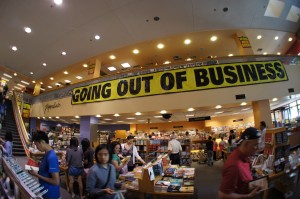 Borders in downtown Seattle.Photo: Chuck Wolfe
Borders in downtown Seattle.Photo: Chuck Wolfe
Cross-posted from myurbanist.
Last week, while the Seattle City Council gave final approval to more street food vendors in public places, Borders Group Inc. began its liquidation of most remaining Borders bookstores, including locations in destination American downtowns.
What’s the relationship? Both stories are about how public and private uses and spaces mix in urbanized areas. Both raise questions of “no net loss” of urban and downtown “third places,” and of how to make a more livable city.
In my view, despite today’s international focus on urban street food vending, the paradigm left behind by Borders leaves bigger questions for back-to-the-city devotees.
Some definitions are in order. “Third place” is a decades-old term, championed by sociologist Ray Oldenburg, for venues which bring people together in the tradition of the American colonial tavern or general store. The idea remains central to urbanist thinking, and describes those places, other than home or work, where we gather, debate, and trade. “No net loss” is a term borrowed from the vocabulary of wetland conservation, and allows for replacement of lost assets with equivalent resources. “No net loss” is the essence of sustainability.
In the last decade, as forms of home and work evolved, conceptions of third places changed as well — from larger-footprint commercial spaces such as Borders, to midsize bookstores (e.g. Third Place Books), to back-to-the-commons public spaces and the pop-up agora. Street-food vending is somewhere in the mix, creating an expanded place of ambience and employment, and — to all but certain bricks and mortar restauranteurs — a likely urban benefit.
In response to the Borders news, some pundits, like Josh Stephens in Planetizen, have called for a better, non-Walmartian reinvention of the bookstore. In his view, big boxes — even when they’re urban — destroy mom-and-pop purveyors. Amazon and Kindle aside, he makes a good case for a new, post-recessionary wave of independent urban bookstore startups. For those bookstores, I hope he is right.
But as to third places — and I am going to assume that “big books” stores can play such a role — there is something bothersome about the demise of Borders’ urban core locations. Yes, it’s perhaps an opportunity for the independent competitor. But what of the potential loss of third-place uses in high-value urban downtowns?
Will the prime square footage occupied by Borders have similar third-place potential once reclaimed? Will replacement uses provide the equivalent fusion business purposes of books, coffee, lecture, and song?
Last week, CNN Money was abuzz with the the newly realized location efficiencies of heading back downtown. In that spirit, let’s hope that downtowns retain dedicated uses of value for those residents and workers who are soon to arrive.
Both the private market and public policymakers should work together to secure the potential prize of livability: no net loss of square footage devoted to urban third places.




